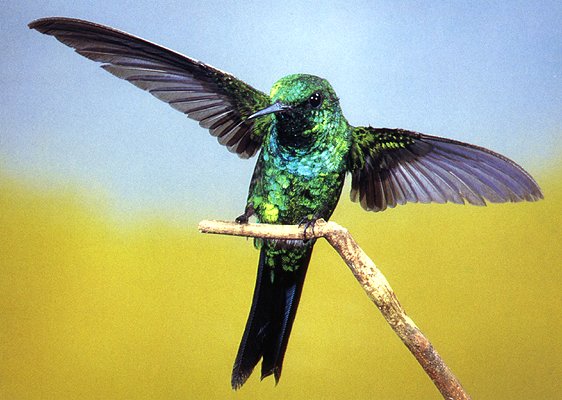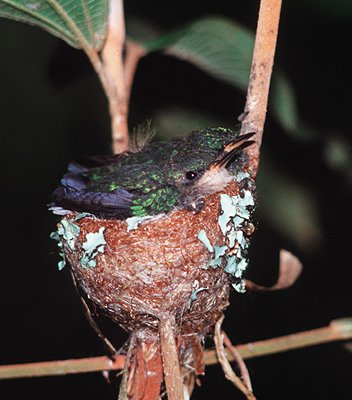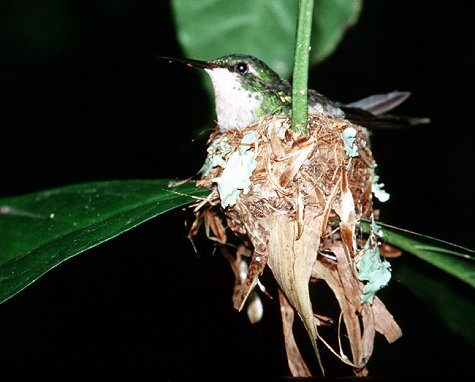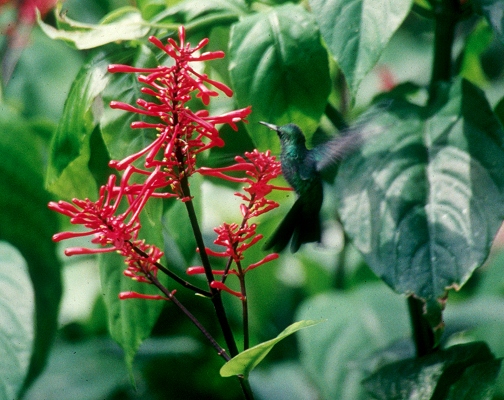|
Puerto Rican Emerald Chlorostilbon maugaeus Esmeralda de Puerto Rico, Zumbadorcito de Puerto Rico
|
 |
|
Male - Photo: R. & E. Tyrrell*
|
|
Puerto Rican Emerald Chlorostilbon maugaeus Esmeralda de Puerto Rico, Zumbadorcito de Puerto Rico
|
 |
|
Male - Photo: R. & E. Tyrrell*
|
|
IDENTIFICATION: The male’s body is iridescent green, with a black, forked tail. The lower bill is flesh-colored or red with a black tip. The female is light below and has a white-tipped tail. Length: 9-11 cm.; weight: 2.8-3.6 g. VOICE: The song is a high-pitched squeal. Also utters a sharp, squeaking note when chasing other hummingbirds. Audio (M. Oberle). HABITAT: Forests, mangroves, and gardens throughout the island. HABITS: Feeds on insects (lantern flies, mosquitoes, and other fly species), spiders, and nectar. The male often forages higher in the forest canopy than the female, and is more likely to feed on nectar. Hummingbirds are very territorial and will mount intense, aerial chases to protect their favorite forest patch. Some Emeralds will "rob" nectar from flowers, by piercing the flower at the base. This deprives the flower of any pollination by the hummingbird, but is a shortcut to a meal from the bird’s point of view. The Puerto Rican Emerald breeds at any time of year, but especially in February-May before the beginning of heavy rains. The nest is a tiny cup made of lichens, tree ferns, and other plant material, and stretches as the two young birds grow. The eggs are tiny: only 8x13 mm. The nest has been used as a folk remedy for asthma. STATUS AND CONSERVATION: The common small hummingbird in most of Puerto Rico, except on the northeast coast, Culebra, and Vieques, where the Antillean Crested Hummingbird replaces it. RANGE: The Puerto Rican Emerald is endemic to Puerto Rico, and is commonest in the western part of the Island. TAXONOMY: TROCHILIDAE; Trochilinae |
 |
|
Male - Photo: G. Lasley
|
 |
|
Photo: R. Rodríguez Mojica
|
 |
|
Female - Photo: R. Rodríguez Mojica
|
 |
|
|
Photo: L. Miranda
|
 |
|
|
Female - Photo: L. Miranda
|
 |
|
Photo: D. North
|
|
References Ackerman, J. D., J.A. Rodríguez-Robles, and E. J. Meléndez. 1994. A meager nectar offering by an epiphytic orchid is better than nothing. Biotropica 26:44-49. Cruz, A. 1987. Avian community organization in a mahogany plantation on a Neotropical island. Carib. J. Sci. 23:286-296. del Hoyo, J., A. Elliott, and J. Sargatal, eds. 1999. Handbook of the Birds of the World, Vol. 5. Barn Owls to Hummingbirds. Lynx Edicions, Barcelona. Gerwin, J. A., and R. M. Zink. 1998. Phylogenetic patterns in the Trochilidae. Auk 115: 05-118. Raffaele, H.A. 1989. A guide to the birds of Puerto Rico and the Virgin Islands. Princeton. Raffaele, H.A. 1989. Una guía a las aves de Puerto Rico y las Islas Vírgenes. Publishing Resources, Inc., Santurce, PR. Raffaele, H.A., J.W. Wiley, O.H. Garrido, A.R. Keith, and J.I. Raffaele. 1998. Guide to the birds of the West Indies. Princeton. Recher, H.F. and J. T. Recher. 1966. A contribution to the knowledge of the avifauna of the Sierra de Luquillo, Puerto Rico. Carib. J. Sci. 6:151-161. Tyrrell, E. Q. and R. A.Tyrrell. 1990. Hummingbirds of the Caribbean. Crown Publishers, NY. Wunderle, J.M., A. Díaz, L. Velasquez, and R. Scharrón. 1987. Forest openings and the distribution of understory birds in a Puerto Rican rainforest. Wilson Bull. 99:22-37. Puerto Rican Emerald, Spanish text Next endemic species in taxonomic order Previous endemic species in taxonomic order |